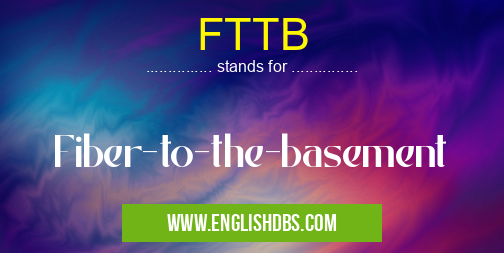What does FTTB mean in COMPUTING
FTTB (Fiber-to-the-Basement) is a fiber optic technology that extends fiber optic cables from a central location to the basement of a building. This technology provides high-speed internet connectivity to multiple units within the building, such as apartments, condos, or businesses.

FTTB meaning in Computing in Computing
FTTB mostly used in an acronym Computing in Category Computing that means Fiber-to-the-basement
Shorthand: FTTB,
Full Form: Fiber-to-the-basement
For more information of "Fiber-to-the-basement", see the section below.
How FTTB Works
FTTB involves installing fiber optic cables from a central distribution point, typically located in the basement or a nearby utility closet. The cables are then distributed to individual units within the building through existing pathways, such as conduits or risers. Inside each unit, the fiber optic cable is terminated at a network interface device (NID), which connects to the user's router or modem.
Advantages of FTTB
- High Speed: FTTB offers significantly faster internet speeds compared to traditional copper-based technologies like DSL or cable. Fiber optic cables transmit data using light pulses, which allows for higher bandwidth and reduced latency.
- Reliability: Fiber optic cables are less susceptible to electromagnetic interference and signal degradation, resulting in a more stable and reliable internet connection.
- Scalability: FTTB can easily be upgraded to support increasing bandwidth demands as technology advances without the need for significant infrastructure changes.
- Future-Proofing: FTTB is a future-proof technology that can support the growing demand for high-speed internet services, including streaming, gaming, and cloud computing.
Disadvantages of FTTB
- Cost: Installing FTTB can be more expensive than copper-based technologies, especially in existing buildings where extensive rewiring may be required.
- Maintenance: Fiber optic cables require specialized equipment and trained personnel for maintenance and repairs.
- Availability: FTTB is not as widely available as copper-based technologies, particularly in older buildings or rural areas.
Essential Questions and Answers on Fiber-to-the-basement in "COMPUTING»COMPUTING"
What is Fiber-to-the-basement (FTTB)?
Fiber-to-the-basement (FTTB) is a fiber-optic broadband technology that extends the fiber optic cable network to the basement of a multi-unit building, such as an apartment complex or office building. From there, the signals are distributed to individual units within the building using existing copper wiring or coaxial cable.
How does FTTB differ from other fiber-optic technologies?
Unlike Fiber-to-the-home (FTTH), which runs fiber optic cable directly to each individual unit, FTTB terminates the fiber at the building's basement or a central location within the building. This allows for a more cost-effective deployment of fiber-optic infrastructure, making it a viable option for multi-tenant buildings.
What are the benefits of FTTB?
FTTB offers several advantages over traditional broadband technologies, including:
- Higher bandwidth: Fiber optic cables can transmit data at significantly higher speeds than copper-based cables.
- Reduced latency: Fiber optic connections have lower latency, which is the time it takes for data to travel from one point to another, making it ideal for real-time applications like gaming and video conferencing.
- Increased reliability: Fiber optic cables are more resistant to electromagnetic interference and physical damage, resulting in a more stable and reliable connection.
What are the limitations of FTTB?
While FTTB provides several benefits, it also has some limitations:
- Cost of deployment: Installing fiber optic infrastructure can be expensive, especially in existing buildings.
- Limited coverage: FTTB is only available in buildings where fiber optic cables have been deployed to the basement.
- Speed limitations: The final leg of the connection from the basement to individual units may be limited by the existing copper or coaxial wiring, potentially reducing the overall speed advantage of fiber.
Final Words: FTTB is a high-speed, reliable, and future-proof technology that provides high-bandwidth internet connectivity to multiple units within a building. While it can be more expensive to install than copper-based technologies, its advantages often outweigh the costs, especially for buildings with high bandwidth demands.
